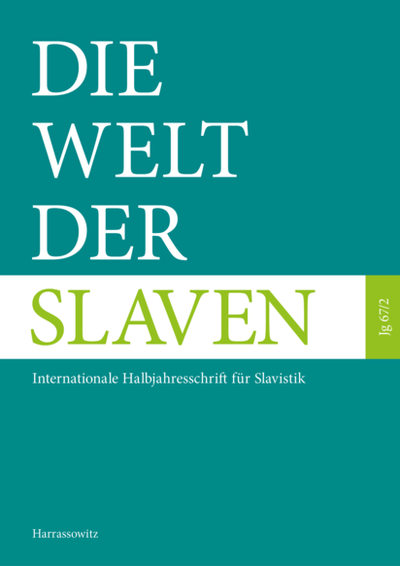Language situation in the district of Homel’ (Belarus)
DOI:
https://doi.org/10.13173/WS.67.2.324Schlagwörter:
language situation, Belarus, Homel’ district, Belarusian, Ukrainian, RussianAbstract
This article describes the language situation in the southern part of the rural District of Homelʹ (Belarus). This border area represents a segment of the Polissian geographic macro-region, which is set across Belarus, Ukraine, the Russian Federation and, to a limited extent, eastern Poland. The territory under examination is characterized by the co-existence of different language codes whose use and distribution depends on a series of more or less interrelated variables. Sociolinguistic data were collected by means of field notes and ad hoc prepared questionnaires during individual field research carried out between spring and autumn of 2017. The illustrative material and the ensuing analysis of data will be preceded by an introductory outline of the most essential aspects of the language situation in the Region of Homelʹ.
Literaturhinweise
Blinava, Ėvelina D. & Mjacelʹskaja, Eŭdakija S. 1980. Belaruskaja dyjalektalohija. Minsk.
Bondarčik, Vasilij K. & Braim, Ivan N. & Burakovskaja, Nina I. 1988. Polesʹe: Materialʹnaja kulʹtura. Kiev.
Danejko, Olena. 2016. Bilorusʹka mova v Bilorusi: Deržavnyj status čy dekoracija? https://dw.com/uk/a-19063646 (accessed 15 Jan 2022).
Del Gaudio, Salvatore. 2013. Russian as a non-dominant variety in Post-Soviet States: A comparison. In Muhr, Rudolf et al. (eds.), Exploring linguistic standards in non-dominant varieties of pluricentric languages, 343–363. Frankfurt am Main.
Delʹ Gaudio, Salʹvatore. 2015. Ukrainsko-russkaja smešannaja rečʹ “suržik” v sisteme vzaimodejstvija ukrainskogo i russkogo jazykov. Slověne 4(2). 211–246.
Del Gaudio, Salvatore. 2017. An introduction to Ukrainian dialectology. Frankfurt am Main.
Del Gaudio, Salvatore. 2018a. Belarusian dialectal features in the local north Ukrainian dialect of Vyšneve. Ricerche Slavistiche 1(61). 113–134.
Del Gaudio, Salvatore. 2018b. Between three languages, dialects and forms of mixed speech: Language and dialect contacts in Ukrainian-Belarusian transitional area. In Salmon, Laura & Ziffer, Giorgio & Ferro, Maria G. (eds.), Contributi italiani al XVI Congresso Internazionale degli Slavisti (Belgrado, 20–27 agosto 2018), 79–93. Firenze.
Del Gaudio, Salvatore. 2018c. Recent changes in the linguistic landscape of Černihiv. Slov’jansʹkyj svit 17. 83–94.
Del Gaudio, Salvatore. 2020. Language situation in the District of Ripky (Černihiv). Russian Linguistics 44(2). 177–201.
Eckert, Penelope. 2000. Linguistic variation as social practice. Oxford.
Gomelʹskij oblastnoj ispolnitelʹnyj komitet. 2021. [Homepage.] http://gomel-region.by/ (accessed 15 Mar 2021).
Haloŭnae statystyčnae ŭpraŭlenne Homelʹskaj voblasci. 1998–2022. [Homepage.] https://gomel.belstat.gov.by/by/ (accessed 16 Jan 2022).
Hentschel, Gerd. 2017. Eleven questions and answers about Belarusian-Russian Mixed Speech (‘Trasjanka’). Russian Linguistics 41(1). 17–42.
Kanstytucyja Rėspubliki Belarusʹ. https://web.archive.org/web/20050228015844/http://asveta.belinter.net/politkanst.html (accessed 16 Jan 2022).
Kittel, Bernhard & Lindner, Diana & Tesch, Svjatlana & Hentschel, Gerd. 2010. Mixed language usage in Belarus: The sociostructural background of language choice. International Journal of the Sociology of Language 206. 47–71.
Kittel, Bernhard & Lindner, Diana & Brüggemann, Mark & Zeller, Jan Patrick & Hentschel, Gerd. 2018. Sprachkontakt – Sprachmischung – Sprachwahl – Sprachwechsel: Eine sprachsoziologische Untersuchung der weißrussisch-russisch gemischten Rede “Trasjanka” in Weißrussland. Berlin.
Konstitucija Respubliki Belarusʹ 1994 goda. http://pravo.by/document/?guid=3871&p0=v19402875 (accessed 16 Jan 2022).
Konstitucija Respubliki Belarusʹ. https://www.pravo.by/pravovaya-informatsiya/normativnye-dokumenty/konstitutsiya-respubliki-belarus/ (accessed 16 Jan 2022).
Mečkovskaja, Nina B. 2005. Postsovetskij russkij jazyk: Novye čerty v sociolingvističekom statuse. Russian Linguistics 29(1). 49–70.
Milroy, Lesley & Gordon, Matthew J. 2003. Sociolinguistics: Method and interpretation. London.
Mioni, Alberto M. 1983. Italiano tendenziale: Osservazioni su alcuni aspetti della standardizzazione. In Benincà, Paola et al. (eds.), Scritti linguistici in onore di Giovan Battista Pellegrini, vol. 1, 495–517. Pisa.
Nacionalʹnyj statističeskij komitet Respubliki Belarusʹ. 2009. https://archive.is/20120523225241/belstat.gov.by/homep/ru/perepic/2009/itogi1.php (accessed 16 Jan 2022).
Norman, Boris. 2008. Russkij jazyk v Belarusi segodnja. Die Welt der Slaven 53(2). 289–300.
Pro zabezpečennja funkcionuvannja ukraïnsʹkoï movy jak deržavnoï. 2019. Verxovna Rada Ukraïny. https://zakon.rada.gov.ua/laws/show/2704-19 (accessed 16 Jan 2022).
Rasinski, Andrėj. 2019. Belaruskaja mova 1918–2018: Na prykladze adukacyi i druku. In Belarusian Institute for Strategic Studies (biss), https://belinstitute.com/sites/biss.newmediahost.info/files/attached-files/2019-2-18%20Mova_Rasinski_FINALIS.pdf (not accessible as of 12 June 2020).
Tagliamonte, Sali A. 2006. Analysing sociolinguistic variation. Cambridge.
Trub, Volodymyr M. 2000. Javyšče “suržyku” jak forma prostoriččja v sytuaciji dvomovnosty. Movoznavstvo 1. 46–58.
Volynec, Tatʹjana N. 2009. Nacionalʹnyj variant russkogo jazyka v Belarusi – mif ili realʹnostʹ? In Mezenka, Hanna M. (ed.), Acta Albaruthenica, Rossica, Polonica: VIII Mižnarodnaja navukovaja kanferencyja «Belaruska-ruska-polʹskae supastaŭljalʹnae movaznaŭstva», tom 1, 16–21. Vicebsk.
Woolhiser, Curt 2012. “Belarusian Russian”: Sociolinguistic status and discursive representations. In Muhr, Rudolf (ed.), Non-dominant varieties of pluricentric languages: Getting the picture. In memory of Prof. Michael Clyne, 227–262. Wien.
Woolhiser, Curt. 2013. New speakers of Belarusian: Metalinguistic discourse, social identity, and language use. In Bethea, David. M. & Bethin, Christina Y. (eds.), American contributions to the 15th International Congress of Slavists, 63–115. Minsk.
Zaprudski, Sjarhej. 2002. Language policy in the Republic of Belarus in the 1990s. http:// belarusguide.com/culture1/literature/Belarusian_Language_Prosecution_in_Belarus.htm (accessed 16 Jan 2022). [First published in Belarus — the third sector people, culture, language, Warsaw 2002.]
Zaprudski, Sjarhej. 2007. In the grip of replacive bilingualism: The Belarusian language in contact with Russian. International Journal of the Sociology of Language 183. 97–118.
Zaprudzki, Sjarhej. 2002. Moŭnaja palityka ŭ Belarusi ŭ 1990‑ja hady. Arche – Pačatak 1. 98–112.
Zeller, Jan Patrick & Sitchinava, Dmitri 2019. The Russian language in Belarus and Ukraine. In Mustajoki, Arto & Protassova Ekaterina & Yelenevskaya, Maria (eds.), The soft power of the Russian language: Pluricentricity, politics and policies, 108–122. London.

